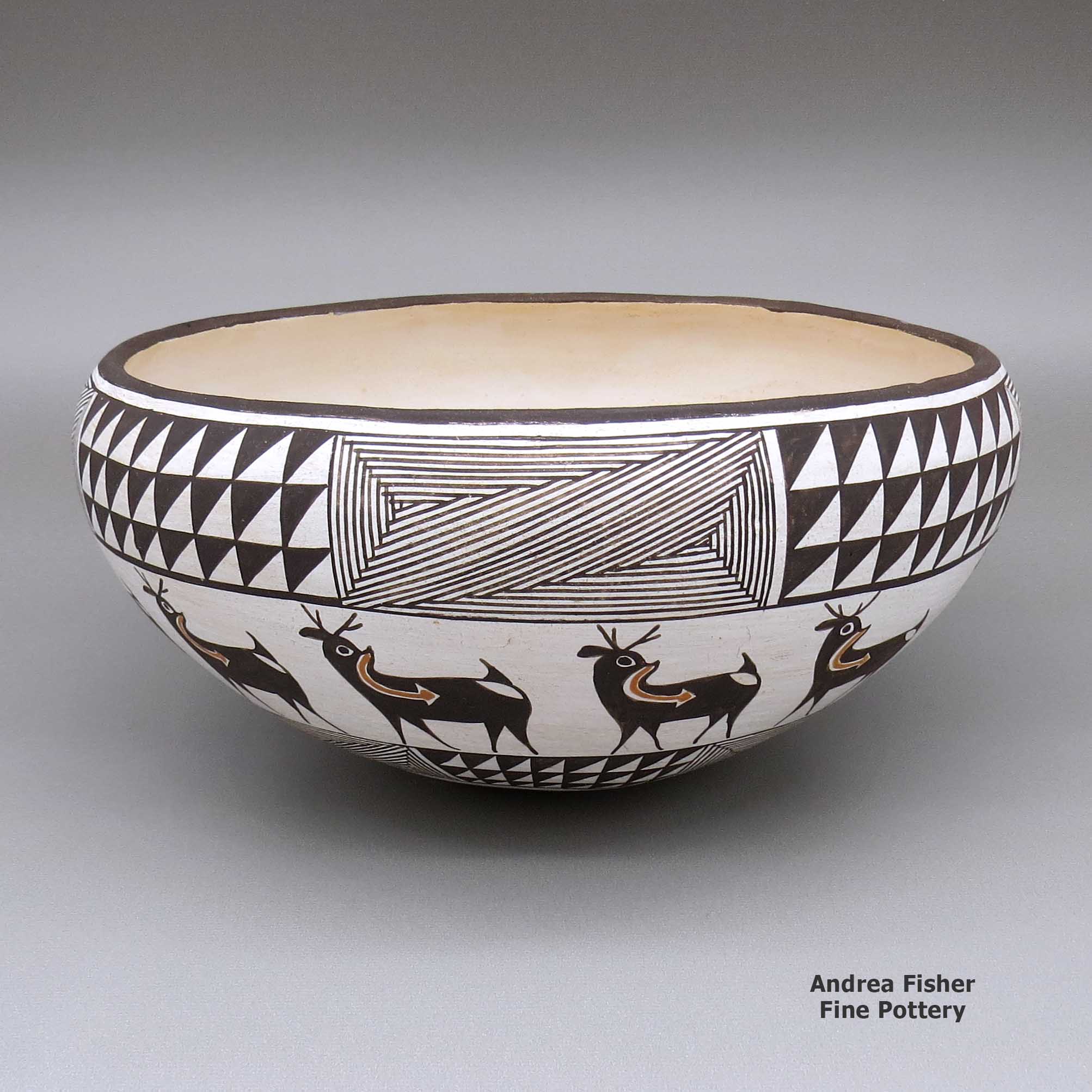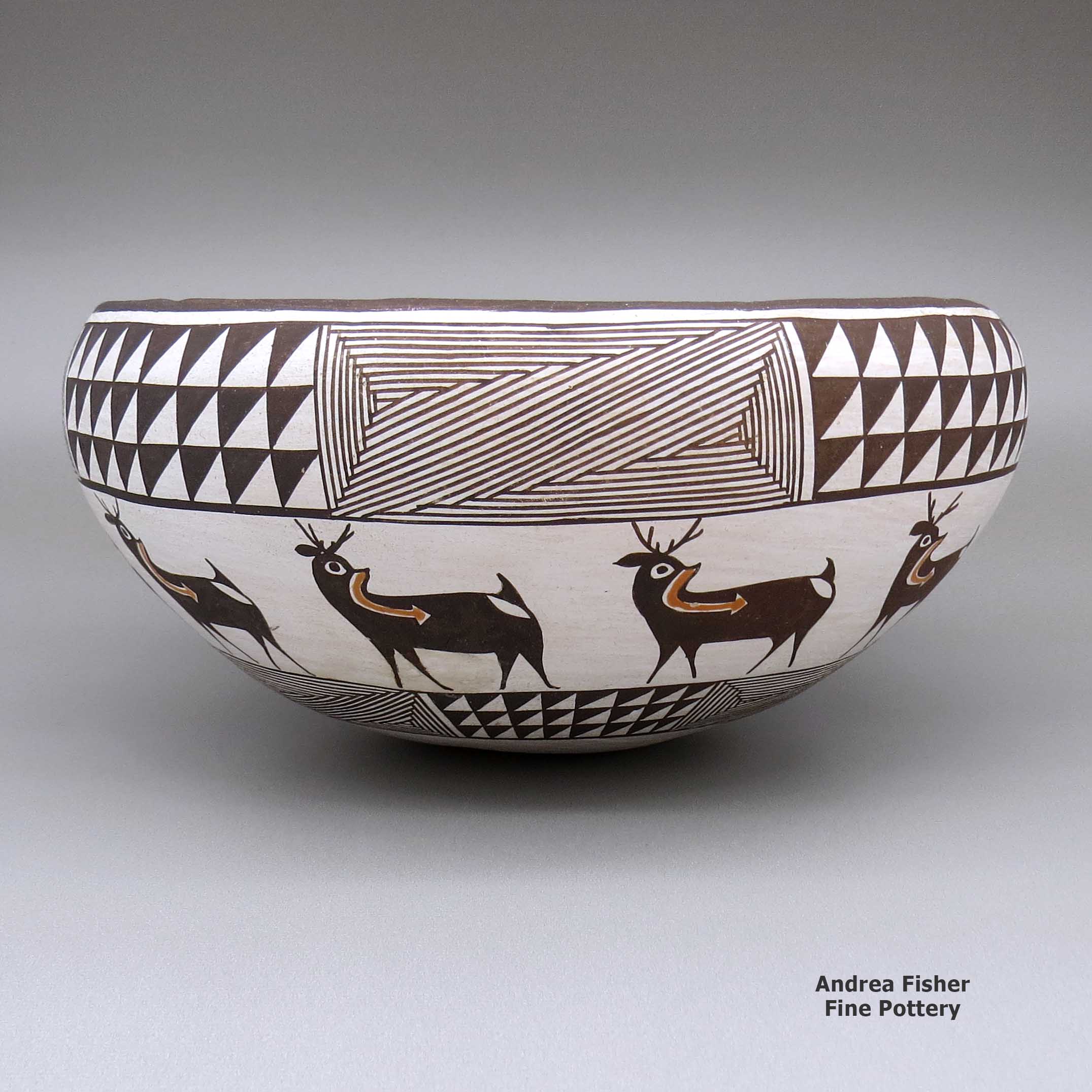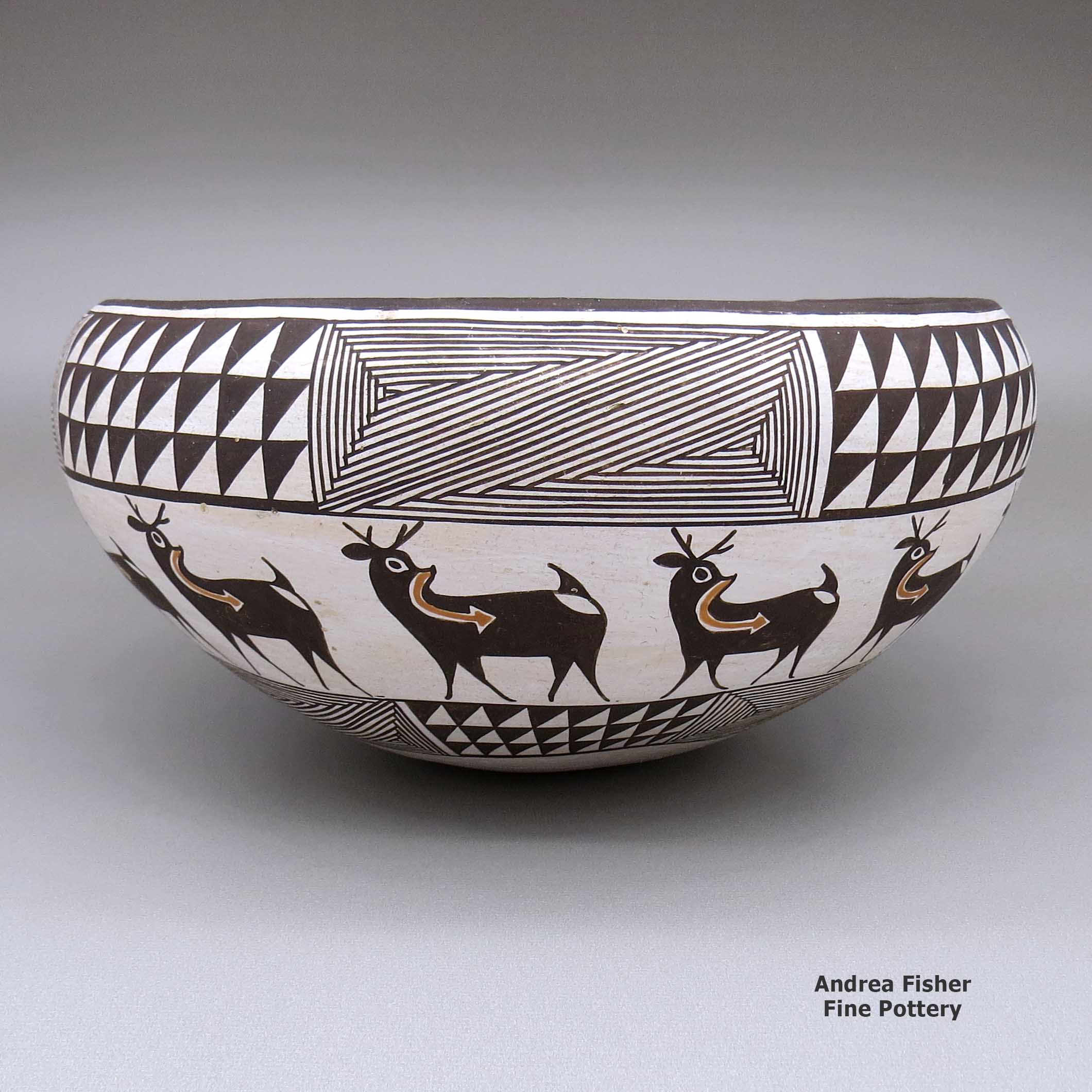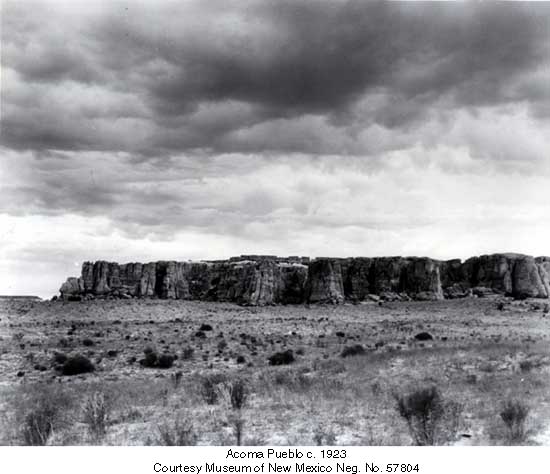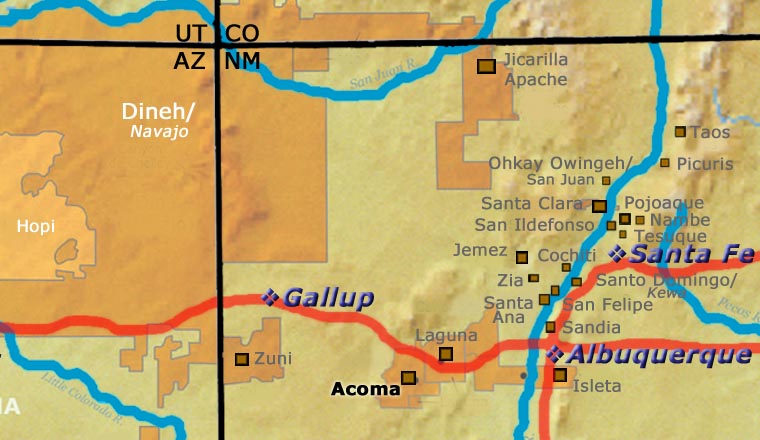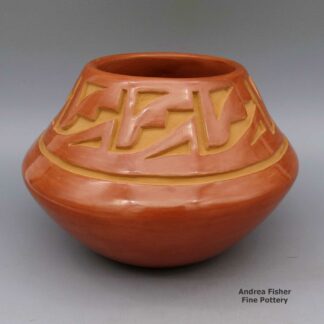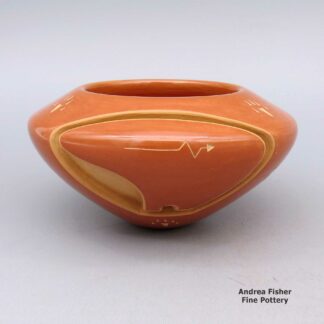| Dimensions | 9.75 × 9.75 × 4.75 in |
|---|---|
| Condition of Piece | Very good, has pitting |
| Signature | Rose Chino Garcia Acoma, New Mexico, with animal print hallmark |
Rose Chino Garcia, dkac3c273, Bowl with deer-with-heart-line design
$1,600.00
A polychrome bowl decorated with a Zuni deer-with-heart-line and Mimbres-style fine line and geometric design
In stock
Brand
Garcia, Rose Chino
Rose Chino Garcia (1928-2000) and her sisters, Carrie Chino Charlie, Vera Chino Ely and Grace Chino, were daughters of the famous Acoma Pueblo potter Marie Z. Chino.
Having learned the best from their mother at an early age and then further developing their art on their own, each of the daughters became a famous potter in their own right.
Rose's designs include cloud forms, double seed jars, butterflies, spirals, rain drops and lightning bolts, among others. "Painting the fine lines is hard on your eyes, you have to rest every so often," she said, describing her efforts.
Rose's pottery is in collections at the Heard Museum in Phoenix, the Peabody Museum at Harvard University and the Philbrook Museum of Art in Tulsa. Among the many awards she earned in her lifetime was one for "Most Creative Design" from the Santa Fe Indian Market.
Rose’s daughter Tena continues the Chino family tradition of creating exceptional pottery.
Some Awards Earned by Rose
- 1996 Santa Fe Indian Market. Class. II - Pottery, Div. F - Traditional pottery, painted designs on matte or semi-matte surface, all forms except jars, Cat. 1305 - Wedding vases, Third Place
- 1993 Santa Fe Indian Market. Class. II - Pottery, Div. G - Traditional pottery, painted designs on matte or semi-matte surface, all forms except jars, Cat. 1405 - Wedding vases, First Place
- 1991 Santa Fe Indian Market. Class. II - Pottery, Div. G - Traditional pottery, painted designs on matte or semi-matte surface, all forms but jars, Cat. 1413 - Miscellaneous, First Place
- 1990 Santa Fe Indian Market. Class. II - Pottery, Div. G - Traditional pottery, painted designs on matte or semi-matte surface, all forms but jars, Cat. 1207 - Seed bowls (over 8"), Third Place
- 1986 Santa Fe Indian Market. Class. II - Pottery, Div. F - Traditional pottery, painted designs on matte or semi-matte surface, jars, Cat. 1206 - Seed bowls (over 8" diameter), First Place
- 1985 Santa Fe Indian Market. Potcarrier Award for Best traditional pottery jar or bowl 15" or more in height/diameter; - Class. II - Pottery, Div. F - Traditional, jars, matte, Best of Division; - Cat. 1207 - Seed bowls (over 8" diameter), Third Place
- 1984 Santa Fe Indian Market. Indian Arts Fund Award for Overall excellence in any traditional craft
- 1983 Santa Fe Indian Market. Class. II - Pottery, Div. F - Traditional, painted designs on matte or semi-matte surface, First Place
A Short History of Acoma Pueblo

According to Acoma oral history, the sacred twins led their ancestors to "Ako." Ako turned out to be a magical mesa composed mostly of white rock. There the sacred twins instructed the ancestors to make that mesa their home. Acoma Pueblo is called "Sky City" because of its position atop the high mesa.
Acoma, Old Oraibi (at Hopi) and Taos all lay claim to being the oldest continuously inhabited community in the U.S. Those competing claims are hard to settle as each village can point to archaeological remnants close by to substantiate each village's claim. Acoma is located about 60 miles west of Albuquerque in a landscape littered with the ruins of ancient pueblos, many more than 1,000 years old.
The people of Acoma have an oral tradition that says they've been living in the same area for more than 2,000 years. Archaeologists feel more that the present pueblo was established near the end of the major migrations in the 1200 and 1300s. The location is essentially on the boundary between the Mogollon (Mimbres), Hohokam (Salado) and Anasazi (Ancestral Puebloan) cultures. Each of those cultures has had an impact on the styles and designs of Acoma pottery, especially since modern potters have been getting the inspiration for many of their designs from pot shards they have found while walking on pueblo lands.
Francisco Vasquez de Coronado ascended the cliff to visit Acoma in 1540. He afterward wrote that he "repented having gone up to the place." But the Spanish came back later and kept coming back.
Around 1598 relations between the Spanish and the Acomas took a nasty turn with the arrival of Don Juan de Oñaté and the soldiers, settlers and Franciscan monks that accompanied him. After making the arduous ascent to the mesa top, de Oñaté decided to force the Acomas to swear loyalty to the King of Spain and to the Pope. When the Acomas realized what the Spanish meant by that, a group of Acoma warriors attacked a group of Spanish soldiers and killed 11 of them, including one of de Oñaté's nephews.
De Oñaté retaliated by attacking the pueblo. His troops burned most of it and killed more than 600 people. Another 500 people were imprisoned by the Spanish. Males between the ages of 12 and 25 were sold into slavery. 24 men over the age of 25 had their right foot amputated. Many of the women over the age of 12 were also forced into slavery. Most were parceled out among Catholic convents in Mexico City.
Two Hopi men were also captured at Acoma. The Spanish cut one hand off of each and sent them home to spread the word about Spain's resolve to subjugate the inhabitants of Nuevo Mexico. Spanish monks did make the trip a few years later but Spanish military made hardly an appearance in Hopiland.
When word of the massacre (and the punishments meted out after) got back to King Philip in Spain, he banished Don Juan de Oñaté from Nuevo Mexico. Some Acomas had escaped that fateful Spanish attack and returned to the mesa top in 1599 to begin rebuilding.
In 1620 a Royal Decree was issued which established civil offices in each pueblo and Acoma got its first governor. That didn't help the people any as those appointed to the government positions were also those most on the take with the Spanish authorities. By 1680, the situation between all of the pueblos and the Spanish had deteriorated to the point where the Acomas were extremely willing participants in the 1680 Pueblo Revolt.
After the successful Pueblo Revolt pushed the Spanish back to Mexico, refugees from other pueblos began to arrive at Acoma. Most feared the eventual Spanish return and probable reprisals. That strained the resources of Acoma badly. Then the Spanish returned in force and residents of the pueblo had to make a hard decision. Many of the refugees chose to try a peaceful solution: they relocated north to the ancient Laguna area and made peace with the Spanish as soon as they reappeared in the region. Acoma held out against the Spanish for awhile but soon capitulated.
Over the next 200 years, Acoma suffered from breakouts of smallpox and other European diseases to which they had no immunity. At times they would side with the Spanish against nomadic raiders from the Ute, Apache and Comanche tribes. Eventually New Mexico changed hands. Then the railroads arrived and Acoma became dependent on goods made in the outside world.
For many years the villagers were content on the mesa. Now most live in villages on the valley floor where water, electricity and other necessities are easily available. A few families still make their permanent home on the mesa top. The old pueblo is used almost exclusively these days for ceremonial celebrations.
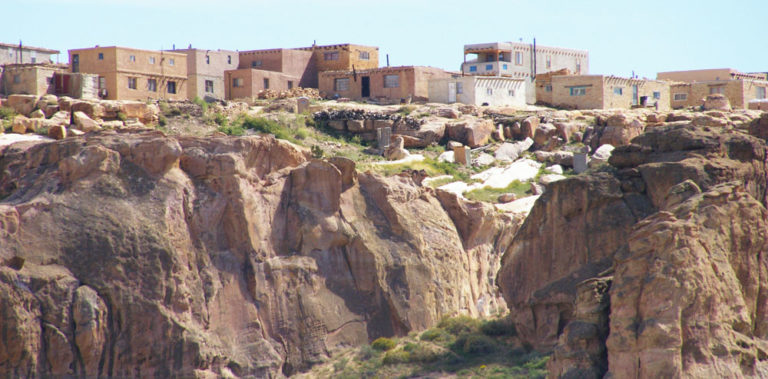
For more info:
Acoma Pueblo at Wikipedia
Pueblo of Acoma official website
Pueblos of the Rio Grande, Daniel Gibson, ISBN-13:978-1-887896-26-9, Rio Nuevo Publishers, © 2001
Acoma & Laguna Pottery, Rick Dillingham with Melinda Elliott, ISBN 0-933452-32-2, School of American Research Press, © 1992
Upper photo courtesy of Marshall Henrie, Creative Commons Attribution-Share Alike 3.0 Unported License
About Bowls
The bowl is a basic utilitarian shape, a round container more wide than deep with a rim that is easy to pour or sip from without spilling the contents. A jar, on the other hand, tends to be more tall and less wide with a smaller opening. That makes the jar better for cooking or storage than for eating from. Among the Ancestral Puebloans both shapes were among their most common forms of pottery.
Most folks ate their meals as a broth with beans, squash, corn, whatever else might be in season and whatever meat was available. The whole village (or maybe just the family) might cook in common in a large ceramic jar, then serve the people in their individual bowls.
Bowls were such a central part of life back then that the people of the Classic Mimbres society even buried their dead with their individual bowls placed over their faces, with a "kill hole" in the bottom to let the spirit escape. Those bowls were almost always decorated on the interior (mostly black-on-white, color came into use a couple generations before the collapse of their society and abandonment of the area). They were seldom decorated on the exterior.
It has been conjectured that when the great migrations of the 11th, 12th, 13th and 14th centuries were happening, old societal structures had to change and communal feasting grew as a means to meet, greet, mingle with and merge newly arrived immigrants into an already established village. That process called for larger cooking vessels, larger serving vessels and larger eating bowls. It also brought about a convergence of techniques, styles, decorations and design palettes as the people in each locality adapted. Or didn't: the people in the Gallina Highlands were notorious for their refusal to adapt and modernize for several hundred years. They even enforced a No Man's Land between their territory and that of the Great Houses of Chaco Canyon, killing any and all foreign intruders. Eventually, they seem to have merged with the Towa as those people migrated from the Four Corners area to the southern Jemez Mountains.
Traditional bowls lost that societal importance when mass-produced cookware and dishware appeared. But, like most other Native American pottery in the last 150 years, market forces caused them to morph into artwork.
Bowls also have other uses. The Zias and the Santo Domingos are known for their large dough bowls, serving bowls, hair-washing bowls and smaller chili bowls. Historically, these utilitarian bowls have been decorated on their exteriors. More recently, they've been getting decorated on the interior, too.
The bowl has also morphed into other forms, like Marilyn Ray's Friendship Bowls with children, puppies, birds, lizards and turtles playing on and in them. Or Betty Manygoats' bowls encrusted with appliqués of horned toads or Reynaldo Quezada's large, glossy black corrugated bowls with custom ceramic black stands.
When it comes to low-shouldered but wide circumference ceramic pieces (such as many Sikyátki-Revival and Hawikuh-Revival pieces are), are those jars or bowls? Conjecture is that the shape allows two hands to hold the piece securely by the solid body while tipping it up to sip or eat from the narrower opening. That narrower opening, though, is what makes it a jar. The decorations on it indicate that it is more likely a serving vessel than a cooking vessel.
This is where our hindsight gets fuzzy. In the days of Sikyátki, those potters used lignite coal to fire their pieces. That coal made a hotter fire than wood or manure (which wasn't available until the Spanish brought it). That hotter fire required different formulations of temper-to-clay and mineral paints. Those pieces were perhaps more solid and liquid resistant than most modern Hopi pottery is: many Sikyátki pieces survived intact after being slowly buried in the sand and exposed to the desert elements for hundreds of years. Many others were broken but were relatively easy to reassemble as their constituent pieces were found all in one spot and they survived the elements. Today's pottery, made the traditional way, wouldn't survive like that. But that ancient pottery might have been solid enough to be used for cooking purposes, back in the day.
About the Deer-With-Heart-Line Design
The "deer-with-heart-line" pattern may have been developed by the potters of ancient Hawikuh. We don't know, but whenever it was developed, a Zuni Pueblo potter known as We'Wha taught it to Arroh-ah-och of Laguna Pueblo in the 1890s and Arroh-ah-och took it back to Laguna and painted it there.
Some potters at Acoma Pueblo were painting the image of a deer in the 1880s but no one painted the deer-with-heart-line design until Lucy Lewis asked for and received permission from the Pueblo of Zuni. Some members of her family have been painting it since but the design hasn't spread through the community like it has through Zuni.
The "heart line" has multiple meanings: it's a prayer of thanks for good health and abundance for the spirit of the deer and good hunting for the hunter.
When the "deer-with-heart-line" pattern appears under the center of a rainbow with mountain and forest symbols on either side, that is "deer-in-his-house," a prayer for abundance and prosperity for all in the environment.
Marie Z. Chino Family Tree - Acoma Pueblo
Disclaimer: This "family tree" is a best effort on our part to determine who the potters are in this family and arrange them in a generational order. The general information available is questionable so we have tried to show each of these diagrams to living members of each family to get their input and approval, too. This diagram is subject to change should we get better info.
-
Marie Zieu Chino (1907-1982)
- Carrie Chino Charlie (1925-2012)
- JoAnn Chino Garcia (1961-) & Lawrence Garcia Sr.
- Lawrence Garcia Jr.
- Trystyn Garcia
- Zachary Garcia
- Corinne Louis (1959-)
- JoAnn Chino Garcia (1961-) & Lawrence Garcia Sr.
- Rose Chino Garcia (1928-2000)
- Tena Garcia (1964-)
- Grace Chino (1929-1994)
- Gloria Chino (1955-)
- Carol Chino (1971-)
- Vera Chino Ely (1943-)
- Gilbert Chino (1946-1999)
- Emmalita Chino (daughter-in-law) (1931-) & Patrick Chino
- Patrick Patricio (1942-) & Doris Concho Patricio (1944-2019)
- Douglas Patricio
- Israel Patricio
- Myron Patricio
- Robert Patricio (1976-) & Melanie Patricio
- Felisha Patricio (1997-)
- Kylie Patricio (1999-)
- Juanita Patricio (2001-)
- Stephanie Patricio (1970- ) & Curtis Nez
